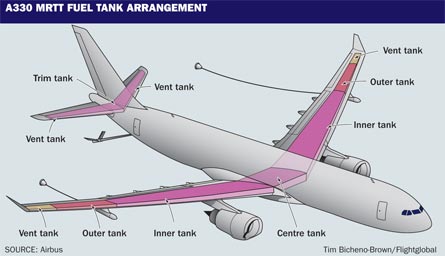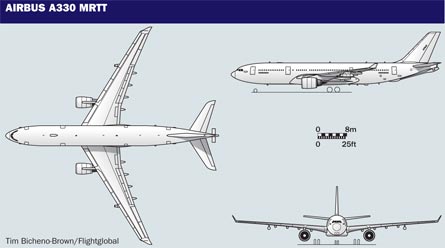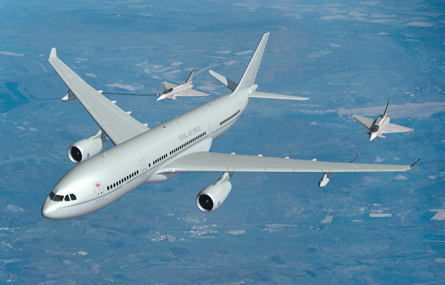The US Air Force's selection of the Northrop Grumman/EADS North America team's Airbus A330-200-based KC-45 in 2008 was one of the most remarkable decisions made within the last several years.
By rejecting Boeing's offer of a KC-767 to meet its KC-X requirement, the service appeared to have removed the company's decades-old dominance of the air-to-air refuelling sector. It also seemed to have vindicated a bid strategy which had promised to deliver a vital commodity: "more".
 With four buyers now on board, EADS hopes its A330 MRTT will dominate the market. Picture: Airbus Military |
|---|
Also in early March, Northrop stepped back from a contest that it considered to be unfairly skewed towards a smaller design, leaving EADS NA to go it alone in pursuit of the 179-aircraft deal.
With the contest now in a 60-day extension period approved by the Department of Defense before responses to a final request for proposals must be tabled on 9 July, the gloves have well and truly come off.
EADS has adopted a far more aggressive stance than Northrop in promoting the KC-45 in a bid to fight back against Boeing and its supporters. Fuelled by the results of a World Trade Organisation investigation, which concluded that some Airbus programmes - including the A330 - had received illegal state subsidies from European governments, the KC-767 NewGen Tanker's promoters have dressed the product as an all-US tanker fighting against a transatlantic raider.
But claiming that its North American activities today support 200,000 US jobs and contribute $11 billion to the economy each year, EADS is promoting its own US credentials.
"The KC-45 will be made in America by tens of thousands of American workers, and build the US economy for today and tomorrow," says EADS NA. If selected, the company will assemble its new tanker in Mobile, Alabama, and also bring in similar work on the new A330-200F freighter.
EADS's head of Airbus military derivatives, Antonio Caramazana, says the KC-45 offering will draw heavily on the company's experience in preparing the A330-200 as the KC-30A for the Royal Australian Air Force. "The basic aircraft and the basic air-to-air refuelling solution is very similar," he says.
 The A330 MRTT has a maximum fuel capacity of 110,000kg |
|---|
"We are working with the RAAF to make the transition," says Caramazana. The service is expected to receive two aircraft late this year before declaring initial operating capability in early 2011. All five of its aircraft will be delivered before full operating capability is achieved during 2012.
EADS would prepare its first prototype KC-45 for the USAF in Getafe, Spain, and complete subsequent aircraft in the USA. It will offer the aircraft with the option of a cargo door, enabling the type to be flown in a passenger/cargo combi configuration, or to carry a freight load of up to 45,000kg (99,200lb).
"The capacity of the A330-200 as a cargo transport is phenomenal," says Caramazana.
Its offering will also use the Cobham 805E fuselage refuelling unit already integrated with one of the UK's first two A330s under the Future Strategic Tanker Aircraft programme. As with all MRTTs sold to date, the design will retain the A330's maximum fuel capacity of 111,000kg.
With Australia's first aircraft now nearing operational use, EADS is highlighting the level of new systems included within Boeing's KC-767 NewGen Tanker, and their potential risk.
"The [US] Air Force shouldn't have to take an expensive gamble on an aircraft that only exists on paper," it says. Selecting a new development would be "a gamble with taxpayer money and the warfighter's future," it argues.
The European Aviation Safety Agency in mid-March granted a civil supplemental type certificate for the MRTT modifications. These include the fly-by-wire boom, an enlarged cockpit with a new operator console for the refuelling system and a universal aerial refuelling receptacle slipway installation to also allow the aircraft to receive fuel from another tanker.
The commercial aircraft's original flight-control laws have also been modified for the latter requirement, enabling a pilot to make more agile inputs in roll.
"It is much more responsive, to keep the aircraft within +/-1ft," says Tim Butler, Airbus project test pilot for the A330 MRTT. "We flew an ex-USAF KC-135 pilot, and he made contact the first time," he notes. "That validates the work that we've done."
In tanker law and with the boom extended, the A330 is restricted to a flight envelope within +2.0g and 0g. A new bank angle mode has been added to its autopilot to provide a more stable tanking platform, says Butler. "It's a great enhancement, as it allows the receiver to stay in contact. It's worked well for us."
Aircraft refuelled during flight testing with Australia's first two KC-30As have included Spanish air force Boeing EF-18s, Portuguese air force Lockheed Martin F-16s and a French air force Boeing E-3F airborne warning and control system platform. The MRTT has also received fuel from a French C-135 tanker.
This work highlighted a safety issue with the wing pod fairing, with the refuelling basket having on one occasion hit the wing while being retracted. The fairing was redesigned to improve hose stability and passed subsequent testing, leading to the late April award of daylight certification to use the hose and drogue system.
Airbus expects its civil certification to be followed "this summer" with military certification from Spain's INTA authority for the hose and drogue system. Flight testing of the aircraft's boom system "is progressing well, and will be completed shortly", it adds.
Located on the enlarged flight deck, the "boomer" operator station features an enhanced vision system which uses images from numerous high definition cameras, and also includes an optional 3D mode.
The same cameras provide images under day, night and dusk conditions, and can be combined to show a 180° panoramic view from wing tip to wing tip.
"We want to give carefree handling to the operator, and to the receiver a reduced workload," says Don Cash, the project's head flight test boom operator. For the operator, the process is hands-off after contact has been made, he notes.
Additional benefits of the system include it automatically knowing, for example, which quantity of fuel to use and which pumps to employ with a specific receiver aircraft.
EADS says the MRTT's size means that it can fly 500nm (925km) before remaining on station for 5h with an available fuel load of 60,000kg. Alternatively, this can be changed to 50,000kg over a 1,000nm distance with a 4h 30min time on station.
In addition to the five ordered by launch customer Australia, Airbus Military has sold a further 23 A330 MRTTs to Saudi Arabia, the United Arab Emirates and the UK.
Australia's third aircraft is now in modification by Qantas Defence Services in Brisbane, Queensland, with this and the programme's last two airframes to undergo customer acceptance flights in the country. An option to buy three more cargo-door equipped MRTTs expired in 2007, but Caramazana says: "we are willing to negotiate again."

The first aircraft for both Saudi Arabia (six) and the United Arab Emirates (three) are now undergoing conversion in Spain, with deliveries to both to start during 2011. The UAE's aircraft will all be completed in Spain and supported locally by Gamco, and there is the possibility for three additional aircraft to be acquired.
Airbus is still negotiating with a potential partner for local involvement in Saudi Arabia, although it says this is not a necessity. "Right now we don't have a solution," says Caramazana. "It has to be a balance between the investment in capital, capabilities and technology transfer."
The first two aircraft from the UK's eventually 14-strong FSTA fleet arrived at Getafe in the second half of last year, and structural modifications have been completed on both. The "prototypes" will be used to support certification activities, with the Royal Air Force's remaining 12 to be modified by Cobham Aviation Services in Bournemouth, Dorset. The entire fleet will carry Cobham 905E wing pods, while half will also use the company's centre fuselage refuelling unit.
The UK's first modified tanker will make its first flight in military guise this September, and enter service in late 2011.
Airbus says it will leverage certification work already performed on Australia's MRTT where possible for the UK programme. After basic certification and qualification, the first two aircraft will be flown to Qinetiq's Boscombe Down facility in Wiltshire to support user trials.
The tankers will be flown with combat types including the BAE Systems Harrier GR9, Eurofighter Typhoon and Panavia Tornado GR4, and with large aircraft such as the Boeing E-3D Sentry and Lockheed Martin C-130J tactical transport.
"We have offered to the market a response to the disadvantage of the old tanker fleet," says Caramazana. Other potential sales opportunities exist in Europe, Asia, the Middle East and South America, he says, with India and France considered near-term prospects.
Airbus Military has also modified several A310 transports for the tanker role for Canada (two) and Germany (four), with the type offering a maximum fuel offload of 60,000kg. Several nations have also ordered air-to-air refuelling equipment for the A400M, which has a 58,000kg capacity.
WHY THE UK SELECTED THE A330 FOR FSTA
The UK's Future Strategic Tanker Aircraft (FSTA) competition also pitted the Airbus A330-200 against Boeing's smaller 767.
Proposed by a BAE Systems, Boeing and Cobham team, the Tanker and Transport Service Company offer was based on delivering a fleet of Rolls-Royce-engined 767-300s to be acquired secondhand from British Airways. This appeared to be a credible means of replacing the Royal Air Force's Vickers VC10 and Lockheed TriStar tanker/transports, which had also seen previous commercial service.
But this perception changed with the RAF's need to perform long-range missions in support of combat aircraft operating above Iraq during the second Gulf War in 2003, and by the demands of the UK's subsequent mission in Afghanistan. Having previously appeared too large, the new-build A330s offered by the EADS UK-led AirTanker consortium suddenly appeared an ideal fit. In addition to delivering air-to-air refuelling services, the type could also be used as a way of providing part of the vital "airbridge" to carry equipment and personnel between RAF Brize Norton in Oxfordshire and Afghanistan.
 The RAF will receive 14 leased A330s under the FSTA deal. Picture: AirTanker |
|---|
Source: Flight International




















